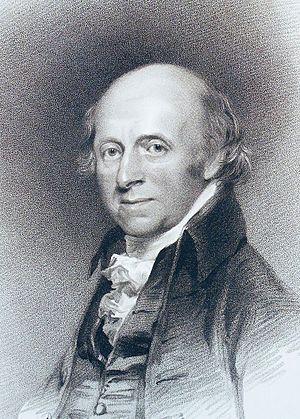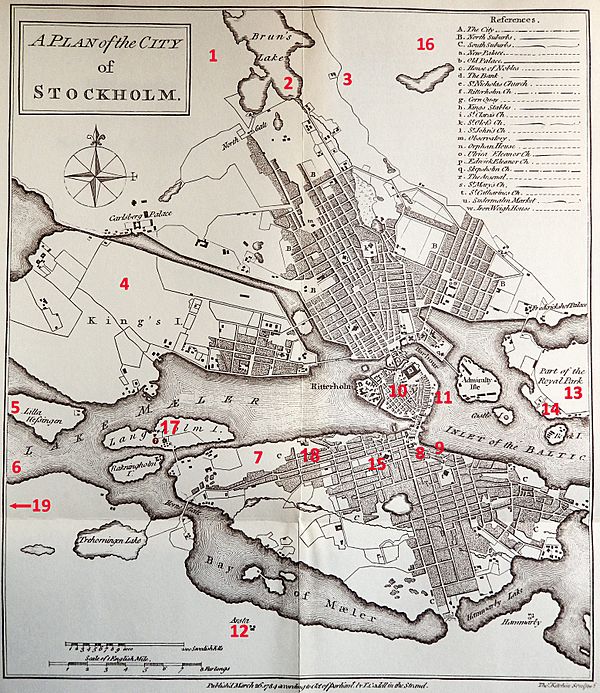William Coxe (historian) facts for kids
Quick facts for kids
William Coxe
|
|
|---|---|

William Coxe engraving by W. T. Fry, 1904
|
|
| Born | 17 March 1748 London, England
|
| Died | 8 June 1828 (aged 80) Bemerton, England
|
| Resting place | Fugglestone St Peter, Wilton, England |
| Nationality | English |
| Education |
|
| Alma mater | King's College, Cambridge |
| Occupation | Historian, archdeacon |
| Years active | 1779–1828 |
| Spouse(s) | Eleanora (née Shairp) |
| Parent(s) |
|
William Coxe (17 March 1748 – 8 June 1828) was an English historian and priest. He worked as a travel guide and teacher for important families from 1771 to 1786. He wrote many history books and travel stories. William Coxe became a deacon (a type of priest) in 1771. He then served as a rector and later an archdeacon in Bemerton, near Salisbury, from 1786 until he passed away.
Contents
Who Was William Coxe?
William Coxe was born on 17 March 1748 in Dover Street, Piccadilly, London. He was the oldest son of William Coxe, who was a doctor for the king's family. His mother was Martha.
William also had a younger brother named Peter Coxe (born around 1753). Peter became a writer and poet, known for his poem "Social Day." After their father died in 1760, their mother married John Christopher Smith, who was a musical assistant to the famous composer George Frideric Handel.
William Coxe's Education
William Coxe went to Marylebone Grammar School from 1753 to 1754. Then, he attended Eton College from 1754 to 1764. In 1765, he started studying at King's College, Cambridge. He earned his first degree (BA) in 1769 and a higher degree (MA) in 1772. From 1768 to 1771, he was a fellow at King's College, which means he was a senior member of the college.
He became a deacon in London on 21 December 1771. A few months later, on 15 March 1772, he became a priest.
Travels and Teaching
William Coxe traveled all over Europe. He worked as a teacher and travel companion for important young men. Some of these included Lord Herbert, who was the son of the Earl of Pembroke, and Samuel Whitbread, who came from a famous brewing family.
He wrote very detailed stories about his travels with Lord Herbert. They explored the Swiss Alps and the French Alps. These travel stories were later published as books.
Life as a Priest
In 1786, William Coxe became the vicar of Kingston upon Thames. In 1788, he became the rector of Fugglestone St Peter-with-Bemerton in Wiltshire. He also served as rector in Stourton, Wiltshire from 1801 to 1811 and in Fovant from 1811 until he died.
In 1791, he was made a prebendary of Salisbury. This is a special type of church official. In 1804, he became the Archdeacon of Wilts, a senior church leader, and held this position for 24 years until his death.
William Coxe passed away on 8 June 1828 in Bemerton at the age of 80. He was buried in St Peter's Church at Fugglestone St Peter. After his death, his large collection of books was sold.
Family Life
In 1803, William Coxe married Eleanora. She was the daughter of William Shairp, who was a consul-general for Russia. Eleanora was also the widow of Thomas Yeldham from St Petersburg.
William Coxe's Writings
William Coxe spent most of his time at Bemerton writing. Besides his travel books, he published many other works. His writing style was very formal and objective, which was common for historians at that time.

1 Haga park (S. 64) – 2 Brunnsviken – 3 Första Torpet (Ep. 80) – 4 Kungsholmen – 5 Hessingen (Ep. 48) – 6 Lake Mälaren (Ep. 48) – 7 Södermalm – 8 Urvädersgränd – 9 Lokatten tavern (Ep. 11, Ep. 59, Ep. 77), Bruna Dörren tavern (Ep. 24, Ep. 38) – 10 Gamla stan (Ep. 5, Ep. 9, Ep. 23, Ep. 28, Ep. 79) – 11 Skeppsbron Quay (Ep. 33) – 12 Årsta Castle – 13 Djurgården Park – (Ep. 25, Ep. 51, Ep. 82) – 14 Gröna Lund (Ep. 12, Ep. 62) – 15 Bellman's birthplace – 16 Fiskartorpet (Ep. 71) – 17 Lilla Sjötullen (Bellmanmuseet) (Ep. 48) – 18 Bensvarvars tavern (Ep. 40) 19 Rostock tavern (Ep. 45)

